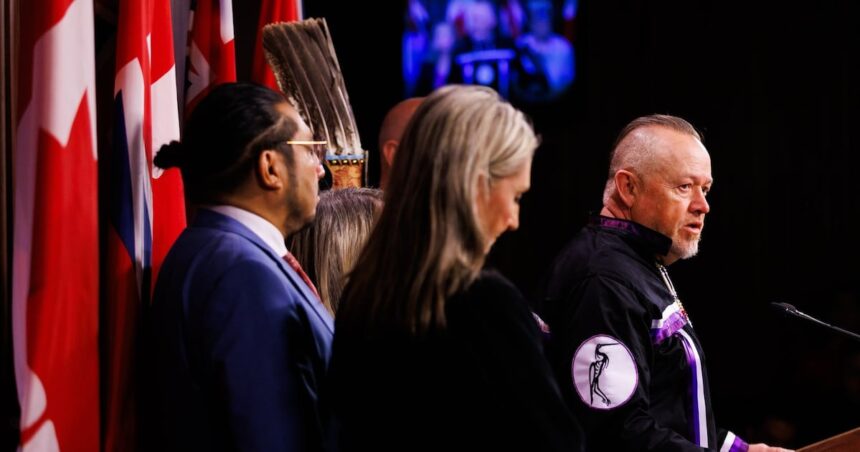I’ve spent the past four days on the ground in Northern Ontario, where the political temperature is rising faster than the summer heat.
Reg Niganobe, Grand Council Chief of the Anishinabek Nation, confirmed yesterday he briefed Ontario Provincial Police about upcoming protests against the province’s controversial “fast-track” housing and infrastructure bills. The meeting signals growing tensions between Indigenous communities and Queen’s Park over legislation many First Nations leaders say tramples treaty rights.
“We’ve maintained open communication with law enforcement,” Niganobe told me during a brief interview at the Anishinabek Nation headquarters in North Bay. “But make no mistake—these are peaceful demonstrations to protect lands that have been ours since time immemorial.”
The protests, expected to begin next week across multiple locations in Ontario, target Bill 109 and companion legislation passed in April. These bills streamline approvals for housing developments and critical infrastructure, reducing environmental assessment requirements in what Premier Ford called “cutting red tape to build Ontario.”
What the premier frames as efficiency, however, Indigenous leaders view as an existential threat.
“These bills effectively bypass the duty to consult,” explained Pamela Palmater, Mi’kmaq lawyer and chair in Indigenous Governance at Toronto Metropolitan University. “When you fast-track development without meaningful Indigenous input, you’re not just violating constitutional obligations—you’re undermining reconciliation itself.”
The OPP briefings come amid heightened sensitivity around Indigenous demonstrations. Statistics Canada data shows 78% of Ontarians support Indigenous rights in principle, yet tensions often emerge when protests affect daily commutes or economic activities. This sentiment was evident at Tim Hortons in Sudbury yesterday, where I overheard mixed reactions to the planned demonstrations.
“I support their right to protest, but I need to get to work,” said electrician Mike Leblanc, stirring his double-double. “There has to be a middle ground.”
Finding that middle ground has proven elusive. The Ford government insists the legislation includes “appropriate consultation mechanisms” while addressing Ontario’s housing crisis. Ministry of Municipal Affairs spokesperson Jennifer Kwok pointed to provisions allowing for expedited but “meaningful dialogue” with affected communities.
Yet documents obtained through freedom of information requests tell a different story. Internal government emails from February show officials acknowledging “limited time for full consultation with First Nations” in the legislative timeline, with one advisor noting the process was “suboptimal but necessary given urgent housing needs.”
Chief Niganobe disputed this characterization. “Housing shortages exist in our communities too. We’re not against development—we’re against development that happens without our consent and threatens lands protected by treaties.”
The brewing confrontation has implications beyond Northern Ontario. Political analysts suggest Premier Ford’s handling of Indigenous relations could impact federal-provincial dynamics, particularly as the Trudeau government navigates its own complex relationship with First Nations.
“The province is testing boundaries,” noted University of Toronto political scientist Melissa Williams, who specializes in Indigenous-Crown relations. “But they’re doing so at a time when Canadians are increasingly aware of the importance of meaningful reconciliation.”
At Zhiibaahaasing First Nation on Manitoulin Island, community members are preparing signs and organizing carpools for next week’s demonstrations. Elder Joseph Hare, 78, told me he never expected to be protesting at his age.
“I thought these fights would be over by now,” he said, carving a small piece of basswood at his kitchen table. “My grandchildren shouldn’t have to defend the same lands I’ve been protecting since the 1960s.”
The Anishinabek Nation, representing 39 First Nations across Ontario, has outlined five key demonstration sites, including Queen’s Park in Toronto and highway intersections near Sudbury and Thunder Bay. Organizers emphasize these will be peaceful gatherings focused on education and visibility.
OPP Commissioner Thomas Carrique issued a statement acknowledging the planned protests while assuring both demonstrators and the public that police are “committed to protecting everyone’s rights while maintaining public safety.”
Recent polling from the Angus Reid Institute suggests Ontarians are divided on the issue—61% support accelerated housing development, but 57% believe Indigenous consultation shouldn’t be sacrificed for speed. This split mirrors broader tensions in Canadian society about how to balance economic growth with treaty obligations.
Back in North Bay, Chief Niganobe emphasized that the Anishinabek Nation’s actions are about protection, not obstruction.
“We’ve always been willing partners in responsible development,” he said. “But partnership requires respect, and these bills show a fundamental lack of it.”
As communities prepare for next week’s demonstrations, the question remains whether Queen’s Park will reconsider its approach or stand firm behind legislation it deems essential to Ontario’s housing strategy. What’s clear is that the conflict reveals deeper questions about whose vision of development will shape Ontario’s future.
For many Anishinabek citizens, that future must include their voice. As I left Zhiibaahaasing, Elder Hare handed me the small carving he’d been working on—a turtle, symbol of Turtle Island.
“Tell them we’re still here,” he said. “And we’re not going anywhere.”






